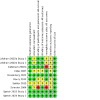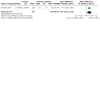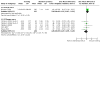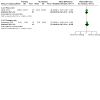Reviewer training for improving grant and journal peer review
- PMID: 38014743
- PMCID: PMC10683016
- DOI: 10.1002/14651858.MR000056.pub2
Reviewer training for improving grant and journal peer review
Abstract
Background: Funders and scientific journals use peer review to decide which projects to fund or articles to publish. Reviewer training is an intervention to improve the quality of peer review. However, studies on the effects of such training yield inconsistent results, and there are no up-to-date systematic reviews addressing this question.
Objectives: To evaluate the effect of peer reviewer training on the quality of grant and journal peer review.
Search methods: We used standard, extensive Cochrane search methods. The latest search date was 27 April 2022.
Selection criteria: We included randomized controlled trials (RCTs; including cluster-RCTs) that evaluated peer review with training interventions versus usual processes, no training interventions, or other interventions to improve the quality of peer review.
Data collection and analysis: We used standard Cochrane methods. Our primary outcomes were 1. completeness of reporting and 2. peer review detection of errors. Our secondary outcomes were 1. bibliometric scores, 2. stakeholders' assessment of peer review quality, 3. inter-reviewer agreement, 4. process-centred outcomes, 5. peer reviewer satisfaction, and 6. completion rate and speed of funded projects. We used the first version of the Cochrane risk of bias tool to assess the risk of bias, and we used GRADE to assess the certainty of evidence.
Main results: We included 10 RCTs with a total of 1213 units of analysis. The unit of analysis was the individual reviewer in seven studies (722 reviewers in total), and the reviewed manuscript in three studies (491 manuscripts in total). In eight RCTs, participants were journal peer reviewers. In two studies, the participants were grant peer reviewers. The training interventions can be broadly divided into dialogue-based interventions (interactive workshop, face-to-face training, mentoring) and one-way communication (written information, video course, checklist, written feedback). Most studies were small. We found moderate-certainty evidence that emails reminding peer reviewers to check items of reporting checklists, compared with standard journal practice, have little or no effect on the completeness of reporting, measured as the proportion of items (from 0.00 to 1.00) that were adequately reported (mean difference (MD) 0.02, 95% confidence interval (CI) -0.02 to 0.06; 2 RCTs, 421 manuscripts). There was low-certainty evidence that reviewer training, compared with standard journal practice, slightly improves peer reviewer ability to detect errors (MD 0.55, 95% CI 0.20 to 0.90; 1 RCT, 418 reviewers). We found low-certainty evidence that reviewer training, compared with standard journal practice, has little or no effect on stakeholders' assessment of review quality in journal peer review (standardized mean difference (SMD) 0.13 standard deviations (SDs), 95% CI -0.07 to 0.33; 1 RCT, 418 reviewers), or change in stakeholders' assessment of review quality in journal peer review (SMD -0.15 SDs, 95% CI -0.39 to 0.10; 5 RCTs, 258 reviewers). We found very low-certainty evidence that a video course, compared with no video course, has little or no effect on inter-reviewer agreement in grant peer review (MD 0.14 points, 95% CI -0.07 to 0.35; 1 RCT, 75 reviewers). There was low-certainty evidence that structured individual feedback on scoring, compared with general information on scoring, has little or no effect on the change in inter-reviewer agreement in grant peer review (MD 0.18 points, 95% CI -0.14 to 0.50; 1 RCT, 41 reviewers, low-certainty evidence).
Authors' conclusions: Evidence from 10 RCTs suggests that training peer reviewers may lead to little or no improvement in the quality of peer review. There is a need for studies with more participants and a broader spectrum of valid and reliable outcome measures. Studies evaluating stakeholders' assessments of the quality of peer review should ensure that these instruments have sufficient levels of validity and reliability.
Copyright © 2023 The Cochrane Collaboration. Published by John Wiley & Sons, Ltd.
Conflict of interest statement
JOH: together with IS, JOH is an author of one of the studies included in this review (Hesselberg 2021). For this study, AF and TD performed screening, data extraction, and risk of bias assessment. JOH is the chief programme officer at The Norwegian Foundation Dam (Stiftelsen Dam), a research funder that also funded the PhD which this systematic review is a part of. IS: together with JOH, is an author of one of the studies included in this review (Hesselberg 2021). For this study, AF and TD performed screening, data extraction, and risk of bias assessment. IS is the head of programme development at The Norwegian Foundation Dam (Stiftelsen Dam). TD: none known. HS: none known. AF: none known.
Figures







Update of
- doi: 10.1002/14651858.MR000056
Similar articles
-
Tailored or adapted interventions for adults with chronic obstructive pulmonary disease and at least one other long-term condition: a mixed methods review.Cochrane Database Syst Rev. 2021 Jul 26;7(7):CD013384. doi: 10.1002/14651858.CD013384.pub2. Cochrane Database Syst Rev. 2021. PMID: 34309831 Free PMC article.
-
Interventions for improving medical students' interpersonal communication in medical consultations.Cochrane Database Syst Rev. 2021 Feb 8;2(2):CD012418. doi: 10.1002/14651858.CD012418.pub2. Cochrane Database Syst Rev. 2021. PMID: 33559127 Free PMC article.
-
The future of Cochrane Neonatal.Early Hum Dev. 2020 Nov;150:105191. doi: 10.1016/j.earlhumdev.2020.105191. Epub 2020 Sep 12. Early Hum Dev. 2020. PMID: 33036834
-
Psychological interventions for improving adherence to inhaled therapies in people with cystic fibrosis.Cochrane Database Syst Rev. 2023 Mar 29;3(3):CD013766. doi: 10.1002/14651858.CD013766.pub2. Cochrane Database Syst Rev. 2023. PMID: 36989170 Free PMC article. Review.
-
Non-medical interventions to enhance return to work for people with cancer.Cochrane Database Syst Rev. 2024 Mar 5;3(3):CD007569. doi: 10.1002/14651858.CD007569.pub4. Cochrane Database Syst Rev. 2024. PMID: 38441440 Free PMC article.
Cited by
-
Peer Review in Pharmacovigilance: Lens on Disproportionality Analysis.Drug Saf. 2024 Jul;47(7):601-605. doi: 10.1007/s40264-024-01419-3. Epub 2024 Mar 18. Drug Saf. 2024. PMID: 38498258 No abstract available.
-
A structured, journal-led peer-review mentoring program enhances peer review training.Res Integr Peer Rev. 2024 Mar 8;9(1):3. doi: 10.1186/s41073-024-00143-x. Res Integr Peer Rev. 2024. PMID: 38454514 Free PMC article.
-
The costs of competition in distributing scarce research funds.Proc Natl Acad Sci U S A. 2024 Dec 10;121(50):e2407644121. doi: 10.1073/pnas.2407644121. Epub 2024 Dec 2. Proc Natl Acad Sci U S A. 2024. PMID: 39621909 Free PMC article.
-
The critical role of peer reviewers: Challenges and future steps.Nordisk Alkohol Nark. 2023 Feb;40(1):14-21. doi: 10.1177/14550725221092862. Epub 2022 Sep 1. Nordisk Alkohol Nark. 2023. PMID: 36793486 Free PMC article.
References
References to studies included in this review
Callaham 2002a Study 1 {published data only}
Callaham 2002a Study 2 {published data only}
Callaham 2002b {published data only}
-
- Callaham ML, Schriger DL. Effect of structured workshop training on subsequent performance of journal peer reviewers. Annals of Emergency Medicine 2002;40(3):323-8. - PubMed
Cobo 2007 {published data only}
Hesselberg 2021 {published data only}
Houry 2012 {published data only}
Sattler 2015 {published data only}
Schroter 2004 {published data only}
-
- Schroter S, Black N, Evans S, Carpenter J, Godlee F, Smith R. Effects of training on quality of peer review: randomised controlled trial. BMJ 2004;328(7441):673. [DOI: 10.1136/bmj.38023.700775.AE] - DOI - PMC - PubMed
Speich 2023 Study 1 {unpublished data only}
-
- Speich B, Mann E, Schönenberger CM, Mellor K, Griessbach AN, Dhiman P, et al. Reminding peer reviewers of the most important reporting guideline items to improve completeness in published articles: primary results of two randomized controlled trials. Personal communication with author 2023. - PMC - PubMed
-
- Speich B. Impact of a short form of the SPIRIT checklist for peer reviewers to improve the reporting of protocols for randomised controlled trials published in biomedical journals: a randomised controlled trial. Open Science Framework 2020. [DOI: 10.17605/OSF.IO/Z2HM9] - DOI - PMC - PubMed
Speich 2023 Study 2 {published data only}
-
- Speich B, Mann E, Schönenberger CM, Mellor K, Griessbach AN, Dhiman P, et al. Reminding peer reviewers of the most important reporting guideline items to improve completeness in published articles: primary results of two randomized controlled trials. Personal communication with author 2023. - PMC - PubMed
-
- Speich B, Schroter S, Briel M, Moher D, Puebla I, Clark A, et al. Impact of a short version of the CONSORT checklist for peer reviewers to improve the reporting of randomised controlled trials published in biomedical journals: study protocol for a randomised controlled trial. BMJ Open 2020;10(3):e035114. [DOI: 10.1136/bmjopen-2019-035114] - DOI - PMC - PubMed
References to studies excluded from this review
Blanco 2020 {published data only}
Chauvin 2017 {published data only}
Cobo 2011 {published data only}
Crowe 2011 {published data only}
-
- Crowe M, Sheppard L, Campbell A. Comparison of the effects of using the Crowe Critical Appraisal Tool versus informal appraisal in assessing health research: a randomised trial. International Journal of Evidence-Based Healthcare 2011;9(4):444-9. [DOI: 10.1111/j.1744-1609.2011.00237.x] - DOI - PubMed
DiDomenico 2017 {published data only}
Gardner 1986 {published data only}
Ghannad 2021 {published data only}
-
- Ghannad M, Yang B, Leeflang M, Aldcroft A, Bossuyt PM, Schroter S, et al. A randomized trial of an editorial intervention to reduce spin in the abstract's conclusion of manuscripts showed no significant effect. Journal of Clinical Epidemiology 2021;130:69-77. [DOI: 10.1016/j.jclinepi.2020.10.014] - DOI - PubMed
Green 1989 {published data only}
Jones 2019 {published data only}
MacAuley 1998 {published data only}
NCT03751878 {published data only}
-
- NCT03751878. Evaluating the impact of assessing during peer review the CONSORT checklist submitted by authors. clinicaltrials.gov/study/NCT03751878?tab=history (first received 21 November 2018).
Pitman 2019 {published data only}
Strowd 2014 {published data only}
-
- Strowd R, Wong V, Aragon-Garcia R, Moon Y, Ford B, Haut S, et al. Use of mentored peer review of standardized manuscripts as an educational tool for neurology residents (P1.335). Neurology 2014;82(10 Supplement):P1.335.
Wong 2017 {published data only}
Additional references
Abdoul 2012
Bhargava 2014
-
- Bhargava S, Fisman R. Contrast effects in sequential decisions: evidence from speed dating. Review of Economics and Statistics 2014;96(3):444-57.
Bol 2018
Bornmann 2006
-
- Bornmann L, Daniel H-D. Potential sources of bias in research fellowship assessments: effects of university prestige and field of study. Research Evaluation 2006;15(3):209-19.
Bornmann 2011
-
- Bornmann L. Scientific peer review. Annual Review of Information Science and Technology 2011;45(1):197-245.
Bruce 2016
Callaham 1998
Chan 2013
Chauvin 2015
Covidence 2021 [Computer program]
-
- Covidence. Version accessed 29 May 2019. Melbourne, Australia: Veritas Health Innovation, 2021. Available at covidence.org.
Danziger 2011
Deeks 2017
-
- Deeks JJ, Higgins JP, Altman DG, editor(s) on behalf of the Cochrane Statistical Methods Group. Chapter 9: Analysing data and undertaking meta‐analyses. In: Higgins JP, Churchill R, Chandler J, Cumpston MS, editor(s), Cochrane Handbook for Systematic Reviews of Interventions Version 5.2.0 (updated June 2017). Cochrane, 2017. Available from www.training.cochrane.org/handbook.
Demicheli 2007
Egger 1997
Elsevier 2023
-
- Elsevier. Role of a reviewer. www.elsevier.com/reviewers/role (accessed 11 Mar 2023).
European Commission 2018
-
- European Commission. HORIZON 2020 in full swing. Three years on. Key facts and figures 2014-2016. European Commission, 2018. Available from: www.kowi.de/Portaldata/2/Resources/horizon2020/H2020-2014-2016-Key-Facts....
European Commission 2021
-
- Directorate-General for Research and Innovation. Horizon Europe, budget: Horizon Europe - the most ambitious EU research & innovation programme ever. Publications Office of the European Union 2021. [DOI: 10.2777/202859] - DOI
Gallo 2018
-
- Gallo S, Thompson L, Schmaling K, Glisson S. Risk evaluation in peer review of grant applications. Environment Systems and Decisions 2018;38(2):216-29.
Goodman 1994
Guthrie 2017
Guyatt 2008
Harbord 2006
-
- Harbord RM, Egger M, Sterne JA. A modified test for small-study effects in meta-analyses of controlled trials with binary endpoints. Statistics in Medicine 2006;25(20):3443-57. - PubMed
Higgins 2003
Higgins 2011
-
- Higgins JP, Green S, editor(s). Cochrane Handbook for Systematic Reviews of Interventions Version 5.1.0 (updated March 2011). The Cochrane Collaboration, 2011. Available from handbook.cochrane.org.
Higgins 2017
-
- Higgins JP, Altman DG, Sterne JA. Chapter 8: Assessing risk of bias in included studies. In: Higgins JP, Churchill R, Chandler J, Cumpston MS, editor(s). Cochrane Handbook for Systematic Reviews of Interventions Version 5.2.0 (updated June 2017). The Cochrane Collaboration, 2017. Available from www.training.cochrane.org/handbook.
Hoffmann 2014
-
- Hoffmann TC, Glasziou PP, Boutron I, Milne R, Perera R, Moher D, et al. Better reporting of interventions: template for intervention description and replication (TIDieR) checklist and guide. BMJ (Clinical Research Ed.) 2014;348:g1687. - PubMed
Horsley 2011
Huber 2022
Jefferson 2007
Lane 2020
-
- Lane JN, Teplitskiy M, Gray G, Ranu H, Menietti M, Guinan E, et al. Conservatism Gets Funded? A Field Experiment on the Role of Negative Information in Novel Project Evaluation. Harvard Business School Technology & Operations Mgt. Unit Working Paper No. 21-007, 2020. Available from: papers.ssrn.com/sol3/papers.cfm?abstract_id=3656495. [WEBSITE: https://papers.ssrn.com/sol3/papers.cfm?abstract_id=3656495]
Langfeldt 2006
-
- Langfeldt L. The policy challenges of peer review: managing bias, conflict of interests and interdisciplinary assessments. Research Evaluation 2006;15(1):31-41.
Lee 2013
-
- Lee CJ, Sugimoto CR, Zhang G, Cronin B. Bias in peer review. Journal of the American Society for Information Science and Technology 2013;64(1):2-17.
Mantel 1959
-
- Mantel N, Haenszel W. Statistical aspects of the analysis of data from retrospective studies of disease. JNCI: Journal of the National Cancer Institute 1959;22(4):719-48. - PubMed
Mulligan 2013
-
- Mulligan A, Hall L, Raphael E. Peer review in a changing world: an international study measuring the attitudes of researchers. Journal of the American Society for Information Science and Technology 2013;64(1):132-61.
National Institutes of Health 2022
-
- National Institutes of Health. Budget. www.nih.gov/about-nih/what-we-do/budget (accessed 11 March 2023). [WEBSITE: https://www.nih.gov/about-nih/what-we-do/budget]
National Library of Medicine 2022
-
- National Library of Medicine. MEDLINE PubMed Production Statistics. National Library of Medicine 2022. [WEBSITE: https://www.nlm.nih.gov/bsd/medline_pubmed_production_stats.html]
Olbrecht 2010
-
- Olbrecht M, Bornmann L. Panel peer review of grant applications: what do we know from research in social psychology on judgment and decision-making in groups? Research Evaluation 2010;19(4):293-304.
Page 2021
Recio‐Saucedo 2022
RevMan Web 2022 [Computer program]
-
- Review Manager Web (RevMan Web). Version 4.12.0. The Cochrane Collaboration, 2022. Available at revman.cochrane.org.
Roumbanis 2017
Sattler 2015
Schulz 2010
Sense About Science 2009
-
- Sense About Science. Peer Review Survey 2009: Full Report. senseaboutscience.org/activities/peer-review-survey-2009/ (accessed 30 July 2020).
Superchi 2019
Teplitskiy 2019
-
- Teplitskiy M, Gray G, Guinan E, Ranu H, Menietti M, Lakhani KR. Do Experts Listen to Other Experts? Field Experimental Evidence from Scientific Peer Review. Harvard Business School, 2019.. Avaialble from www.hbs.edu/ris/Publication%20Files/19-107_06115731-d0ae-4a11-ab1d-ecaec....
van Rooyen 1999
-
- Rooyen S, Black N, Godlee F. Development of the review quality instrument (RQI) for assessing peer reviews of manuscripts. Journal of Clinical Epidemiology 1999;52(7):625-9. - PubMed
Walker 2015
Wang 2015
-
- Wang Q, Sandström U. Defining the role of cognitive distance in the peer review process with an explorative study of a grant scheme in infection biology. Research Evaluation 2015;24(3):271-81.
Ware 2015
-
- Ware M, Mabe M. The STM Report - an overview of scientific and scholarly journal publishing. Available from www.stm-assoc.org/2015_02_20_STM_Report_2015.pdf 2015.
Warne 2016
-
- Warne V. Rewarding reviewers – sense or sensibility? A Wiley study explained. Learned Publishing 2016;29(1):41-50.
References to other published versions of this review
Publication types
MeSH terms
LinkOut - more resources
Full Text Sources
Miscellaneous

